Puppy Weight Chart: A Guide for Tracking Your Puppy’s Growth
Don’t you think every pet owner is concerned about their dog’s or furry friends’ growth and proper development? Well, frequent vet visits can break the bank of pet owners. Hence, a friendly way to know about proper growth is what everyone is looking for. That’s where the puppy weight chart comes in, which helps to know how well your dog is developing.
In other words, it’s like a road map for your puppy’s healthy development that provides information about the size, nutrition, and overall well-being—thinking about how a puppy weight chart works and where you can get one. Well, getting a puppy weight chart isn’t a difficult task, but reading or calculating your dog’s weight to know about its growth is what concerns you. Browse with us till the end to know every bit about the same.
So what’re you waiting for? Let’s explore and know how good your puppy’s progress is.
What is the Puppy Weight Chart?
A puppy weight chart is a tool that helps you know about your dog’s weight with time, say from birth to adulthood. It helps you keep track of their growth, which in turn ensures they are growing at a proper rate.
Need for Puppy Weight Chart
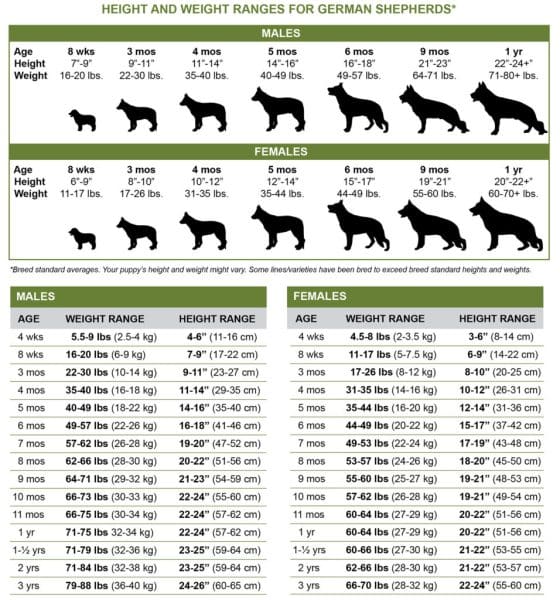
- Know About Health: Analyzing the puppy mentioned above weight chart German Shepherd or any other puppy’s weight Chart will help you to monitor your dog’s health. This includes sudden weight loss or gain, which is sometimes an early sign of illness; knowing beforehand can help refrain from the same.
- Provide Proper Nutrition: They help determine whether a dog receives the right nutrition. This applies to puppies as they go through rapid growth phases, and hence, nutrition needs to be changed accordingly. A weight chart can help with the same.
- Breed-Specific Patterns: This means different dog breeds go through different growth patterns. Some grow rapidly in the early months and then gradually decrease, while others grow steadily for a long time. Puppy weight charts can help you understand what is right for your dog’s breed and age.
- Refrain from Obesity: Being overweight is a real concern for dogs. A weight chart is essential and ensures your dog weighs in a healthy range.
- Pregnancy and Lactation: These charts are very helpful for breeding dogs as they ensure the mother and the baby are healthy throughout the process.
Factors on Which Dog’s Weight Depends

Use puppy weight charts effectively; you must weigh your dog regularly and note the result. Further, the growth rate may vary even between dogs of the same breed; therefore, considering factors on which a dog’s weight depends is necessary.
The listed points below will make you aware of the same:
- Genetics: The foremost factor on which a dog’s size depends, which makes every breed of different sizes. Remember, variations can be there even between the same breed.
- Breeds: Different breeds have specific size categories, namely: toy, small, medium, large, and giant. We’ll elaborate on this in a while.
- Nutrition: Proper nutrition ensures your puppy grows to its potential size. Underfeeding or overfeeding may hamper health.
- Neutering/Spaying: Yes, the timing of neutering impacts dogs’ growth, i.e., either makes your dog larger or smaller. Various studies back the same fact.
Puppy Weight Chart by Breed Categories
1. Toy Breed
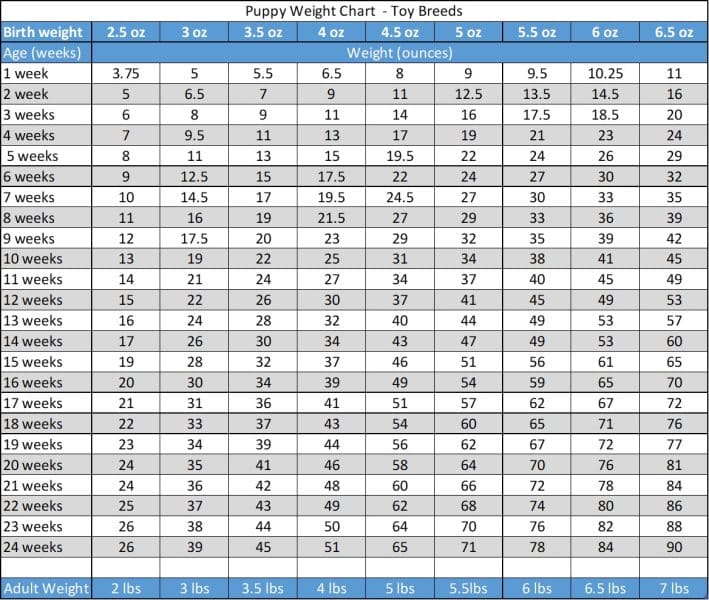
Categories of very small dogs are mostly known for their adorable and charming appearance. A few breeds under this category are Chihuahuas, Pomeranians, and Yorkshire terriers. Rarely any dog categorized under toy breeds weighs more than 12 pounds,i.e., 5.4 kg when fully grown. These adorable pups grow fast during the first few months and reach full size in about 6 to 12 months, depending upon the breed.
Calculating Weight: To know their expected adult weight, double it at 12 weeks.
2. Small Breed
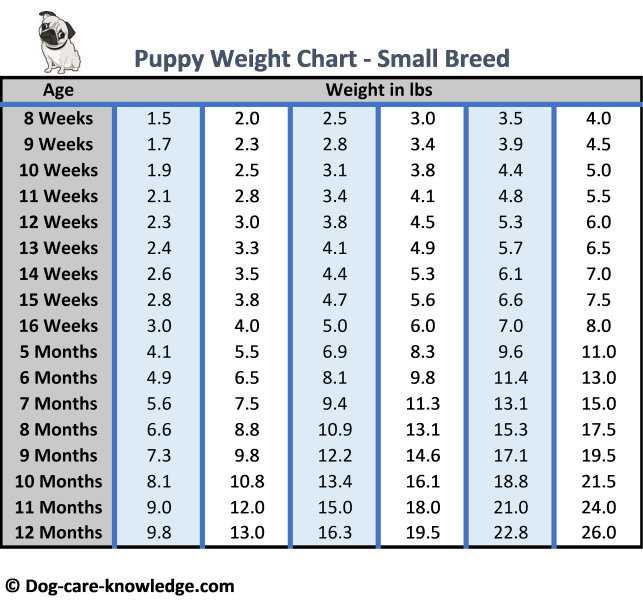
Small-category dogs encompass a diverse range of breeds, mostly known for their size and unique characteristics. Some notable names among these breeds are Beagles, Shih Tzus, and French bulldogs. Small breed dogs generally weigh between 12 to 25 pounds, i.e., 5.4 to 11.3 KG once they reach adulthood. Talking about the growth rate, it is relatively fast for most small breeds. This helps them reach their full size in 9-12 months.
Calculating Weight: To know the dog’s weight, categorized under small breed, use the formula:
Adult Weight: (Puppy Weight/Puppy age in weeks)*52.
3. Medium Breed
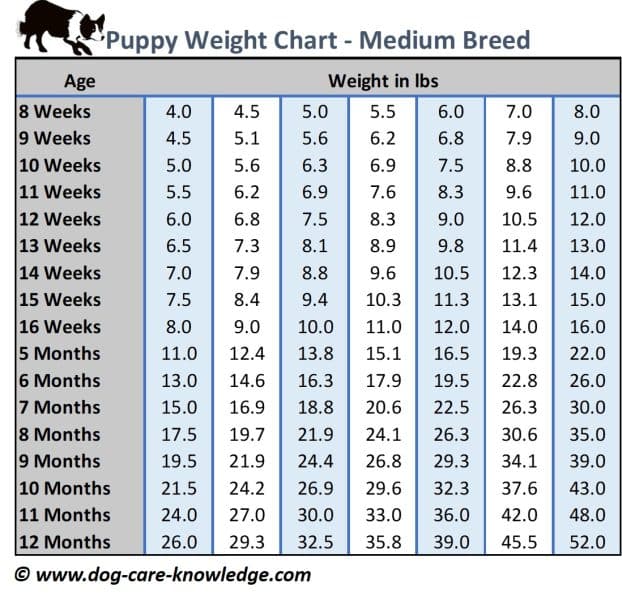
Medium breeds dogs are very popular, generally because they boast special features most demandable for their unique traits. Some common examples of medium-sized dog breeds are Labrador Retrievers, Bulldogs, and Boxers. These dogs, when they reach their adult stage, weigh between 25 to 50 pounds, which equals 11.3 to 22.7 kilograms. However, this may vary in certain cases. The growth rate for medium-sized breeds varies, but generally, they take around 12 to 18 months to reach adulthood.
Calculating Weight: Use the below formula to know the weight of a fully grown dog under medium breed.
Adult Weight (in lbs): weight at 14 weeks (in lbs) × 2.5.
4. Large Breeds
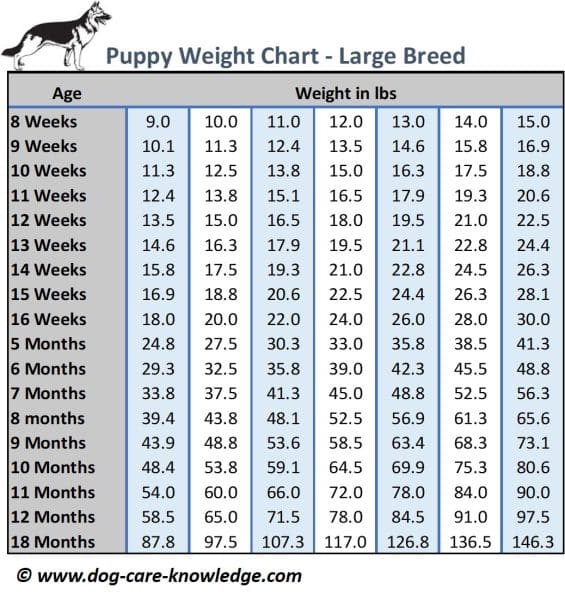
Not to say large breed dogs are noticeable for their size, but what adds more to their personality is their loveable and gentle nature. This group includes species like German Shepherd, Saint Bernards, and Bernese Mountain. When adults, these large breed dogs generally weigh between 50-100 pounds (23-45 kg) but exceed in certain cases. Compared to other dog breeds like toys, small or medium, their growth rate is slow. They take around 18 to 24 months to reach their full size.
Calculating Weight: For calculating the adulthood weight of dogs under large breed, use the same formula as the medium breeds, i.e.
Adult Weight in lbs: weight at 14 weeks (in lbs) × 25
5. Giant Breed
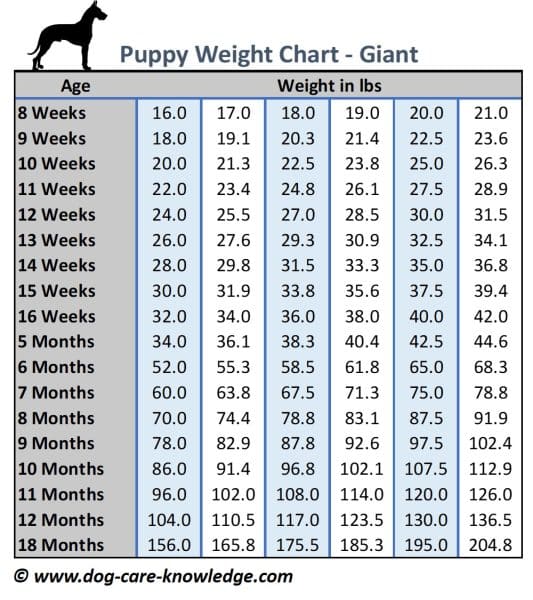
Giant Breed dogs are called ‘helping dogs’, originally bred to help people in tasks such as protecting families, guarding livestock, and more. They are loyal, affectionate, hard workers, and aloof with strangers. Some common names in the category include Great Dane, Irish Wolfhound, Mastiff, and many others. They generally weigh over 100 pounds, i.e., 90 kilograms, and that’s what is back for their inclusion in the giant breed. However, they grow that big in 24-36 months, which means their growth rate is lower than larger breeds.
Calculating Weight: To know the weight of fully grown giant dogs, follow the steps:
- Firstly, divide the dog’s weight at 20 weeks by their current age in weeks.
- Multiply the number you get in the first step by 52.
For example, consider you own a giant dog, and it weighs 45 pounds at 20 weeks. So, in the first step, it will be 45 / 20, 2.25. Then, by multiplying 2.25 by 52, we will get 117 pounds, around which your Giant dogs will weigh on reaching adulthood.
Steps to Know Any Dog’s Future Weight
As said above, a dog’s weight depends on various factors like their breed, genetics, diet they get, age, and overall health. Therefore, it’s quite difficult to know how much a dog will weigh in the future, but the ‘4-7 month rule’ is famous for providing a roundabout answer.
Here are the general guidelines for knowing the same:
1. Firstly, weigh your puppy and know what your puppy’s current weight is.
2. Determine how old your puppy is. The above-incorporated puppy weight chart images are of great help; do refer to them.
3. Use the Rule:
- For small breeds like chihuahua and toy puddles, double the weight at 14 weeks or multiply the weight by 2.5.
- To know the weight of medium breeds like Bulldogs and cocker spaniels double the weight at 16 weeks.
- For large breeds like Labrador or Golden retrievers, double the weight in 20 weeks. For example, if you weigh your puppy at 5 months old, their estimated adult weight will be around 40 pounds based on the ‘4-7 month rule’.
Steps to Know Any Dog’s Future Height (inches/Centimeters)

Before we dive into the steps, it’s necessary to know that the size of a dog can vary greatly due to various factors like genetics, breeds, nutrition, health, environment, and neutering. As said, dogs are categorized depending upon size, but the above one was for height; here is for height.
- Toy Breeds: Includes dogs like Maltese, Havanese, Pug, and more. Dogs under toy breeds don’t exceed 10 inches(25 centimeters) in height.
- Small Breeds: Dogs like pinschers, papillon, and bichon frise are under this category. Small breed dogs’ heights are between 10-18 inches, which equals 26-46 centimeters.
- Medium Breeds: Australian Shepherd, Basset Hound, Collie, and more under medium breeds. Usually, the height of these dogs varies between 18-24 inches(46-61 centimeters).
- Large Breeds: Large breeds encompass dogs like Tosa Inu, Saint Bernard, Boerboel, and more. Their height is between 24-30 inches, i.e. 61-76 centimetres.
- Giant Breeds: Giant Breeds dog’s height goes over 30 inches (70 centimeters), which includes dogs like Great Pyrenees, Scottish Deerhound, Newfoundland, and more.
Now that you know the categories, measure the puppy’s height in inches at 6 months old. Then, multiply the outcome by 100. Whatever you get, finally divide it by 75 to know the height. If you’re thinking about how the above categories come into use, they help in choosing the right dog growth chart and, hence, in getting the height.
How to Use a Dog Size Calculator?
A dog size calculator is a tool that can help you predict the future size of a puppy when it becomes an adult. However, it’s important to note that these calculators aren’t 100% accurate, but yeah, they can’t provide a roundabout value near to which will be your puppy’s adulthood weight.
Using a dog size calculator is easy but depends upon which you are choosing. Let’s suppose you’re using a spirit dog size calculator; follow the below steps, and you’ll get to know.
- Select the dog breed whose size is to be calculated.
- Now select the gender.
- Insert your puppy age in a week.
- Insert your puppy weight in pounds.
- Finally, click the ‘Predict adult dog weight’ button.
Following these 5 steps, you can know your puppy’s adult weight based on a standard puppy weight chart in kg, used for analyzing body weights of dogs of various sizes.
General View on A Puppy Weight Calculator
The puppy weight calculator relies on research made so far, puppy weight charts, and breed-specific standards. This means these calculators use specific formulas that consider several essential factors like breed, gender, current weight, and age to estimate a puppy’s future size.
The accuracy of this calculator is more informed in dog breeds for typically mature and 12 months, that is, 52 weeks. This doesn’t mean that their prediction is wrong for medium and large size; it’s near to but not 100% accurate.
Summing It Up
A puppy weight chart is of great use to know about the roundabout weight of your puppy on reaching adulthood. But remember, when using a puppy weight chart, frequent veterinary visits aren’t much required, but yeah, it’s necessary to visit at least once a month.
Doing so will ensure your puppy grows properly and at a good rate. Puppy weight calculators are a great alternative to the same. However, in both cases, you need to be aware of different categories of dog sizes.
Hope the articles help you in finding your puppy’s future weight. If you have any queries, please ask us in the comment box, and we’ll respond promptly.
Frequently Asked Questions
What is a Puppy Weight Chart?
A puppy weight chart is a calculator that helps you keep track of a puppy’s growth and development. This, in turn, keeps your puppy healthy and refrains from issues like obesity. However, they display average weight ranges for different breeds and ages, which isn’t 100% accurate, but yeah, near to value.
When to Use a Puppy Weight Chart?
There isn’t a specific period; in fact, it’s best if you start using a puppy weight chart right from birth. It will help you know that your puppy is growing healthily, which is necessary for their overall well-being.
How to Find the Right Puppy Weight Chart?
Finding the right puppy weight chart is necessary; otherwise, the chances are high that you’ll get inaccurate weight. The right puppy weight charts are the one that aligns with your dog’s breed and size category, which should be from a reputed breed club or veterinarian.
What to Do if Puppy Weight Doesn’t Align with Chart Averages?
Remember, each puppy is unique; the puppy weight chart is just a means to make you aware of the general guidelines; hence, individual variations are common. It’s best to consult a veterinarian if your puppy’s weight doesn’t match the chart averages.
How to Ensure a Puppy’s Healthy Growth Using the Chart?
Firstly, maintain a balanced diet, provide regular exercise, and schedule routine veterinary checkups over a period. Now, use puppy weight charts to monitor the progress. However, remember that well-being is also mentioned in other factors like breed, genetics, and more.






